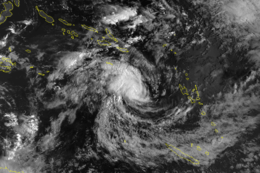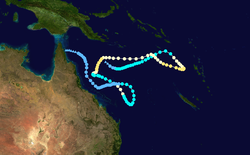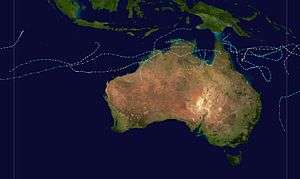Cyclone Katrina
Severe Tropical Cyclone Katrina was a long-lived and erratic tropical cyclone, which moved around Australia during parts of January and February 1998. The initial system developed on 2 January and meandered within the Coral Sea between the Queensland coast and Vanuatu for the next three weeks. After its decay the remnants of Katrina moved westward over Cape York Peninsula, past the Northern Territory and into the Indian Ocean.
| Category 4 severe tropical cyclone (Aus scale) | |
|---|---|
| Category 2 tropical cyclone (SSHWS) | |
 Satellite image of Katrina on January 13, 1998 | |
| Formed | 1 January 1998 |
| Dissipated | 25 January 1998 |
| Highest winds | 10-minute sustained: 165 km/h (105 mph) 1-minute sustained: 165 km/h (105 mph) |
| Lowest pressure | 940 hPa (mbar); 27.76 inHg |
| Fatalities | 2 total |
| Damage | $8.66 million (1998 USD) |
| Areas affected | Solomon Islands, Vanuatu, Northern Australia |
| Part of the 1997–98 Australian region and the South Pacific cyclone season | |
Meteorological history

On 1 January, the Australian Bureau of Meteorology (BoM) started to monitor a tropical low, that had developed within the monsoon trough about 630 km (390 mi) to the east-northeast of Cairns in Queensland, Australia.[1][2] During that day the system moved south-eastwards, before it entered an area of weak steering flow, which made the system perform a small cyclonic loop over the next two days.[3][4][5] Early on 3 January the United States Joint Typhoon Warning Center initiated advisories on the system and designated it as Tropical Cyclone 12P.[4] This was after the system had rapidly intensified and a wind report of 57 km/h (35 mph) had been received from Lihou Reef.[4] At around the same time the BoM named the system Katrina, as it had become a Category 1 tropical cyclone on the Australian tropical cyclone intensity scale.[2][3] After the system was named an increase in the deep westerly flow to the north of the system, caused Katrina to start moving north-eastwards towards the South Pacific basin.[1] Over the next few days the system slowly intensified further as the systems inflow, was dominated by Cyclone Susan which was rapidly intensifying to the west of Vanuatu.[6] Susan's outflow also caused a moderate amount of vertical wind shear over Katrina, which helped to inhibit development of the system and weakened it slightly.[7][8]
Katrina crossed 160°E and moved into the South Pacific basin during 7 January where it was monitored by the Fiji Meteorological Service, as it passed about 90 km (55 mi) to the south of Rennell Island in the Solomon Islands.[3][9] The system subsequently started move south-eastwards towards the island nation of Vanuatu, as started to intensify quicker as Susan moved south-eastwards towards Fiji.[6][9] The system subsequently came to within 220 km (135 mi) of Vanuatu's northernmost island Espiritu Santo, before it recurved westwards during 9 January, because of a weakening of the monsoonal westerlies and the development of an anticyclone to the south of the system.[5][9] Later that day the FMS reported that the system had peaked as a Category 3 severe tropical cyclone, on the Australian scale with 10-minute sustained wind speeds of 150 km/h (90 mph).[3][9] The JTWC also reported during 9 January that the system had peaked with 1-minute sustained wind speeds of 165 km/h (105 mph), which made the system equivalent to a category 2 hurricane on the Saffir-Simpson hurricane wind scale.
On 11 January, Katrina moved south of Rennell Island and then crossed back into the Brisbane area six hours later where it crossed the 160E on its eastward journey, then the storm turned west where it maintained that course until 15 January. On the 15th, the storm moved south-southwest where it reached Saffir–Simpson Hurricane Scale Category 2 strength with a barometric pressure of 940 mbar. Katrina weakened rapidly and slowed before making a tight loop on 17 and 18 January.[2] After completing the loop, Cyclone Katrina moved east for 12 hours before moving east-southeast for three days. During that time, Katrina briefly reached Category 1 strength once more before slowing down and being affected by wind shear. By 24 January, Katrina had weakened to a tropical depression.[2] Over the next few days Katrina's remnant low moved south-westwards before turning northwestwards during 28 January. The system was last noted by the JTWC on 2 February just off the Cape York Peninsula.
Katrina's remnants drifted across the Cape York Peninsula, until they reorganized on 8 February into Cyclone Victor, later dubbed Cindy by the Mauritius Meteorological Service.[10] The system persisted until 19 February.[11] Thus, the full lifetime of the tropical system, from its formation in the Coral Sea until it completely dissipated in the central Indian Ocean was 51 days.[12]
Impact
Cyclone Katrina impacted parts of Queensland, Australia, Vanuatu and the Solomon Islands, where it caused two deaths and in damages.[9] Fears were also raised that Katrina could threaten Fiji, as it interacted with Cyclone Susan which in turn interacted with Cyclone Ron.[9][13] Due to the impact of this storm, the name Katrina was retired from the lists of tropical cyclone names for the Australian region.[14]
Katrina passed near the Solomon Islands on two separate occasions while it was active, with the cyclone first affecting the archipelago between 6–8 January, before grazing the archipelago during 11 January.[5][15] As the system affected the archipelago, Katrina brought heavy rainfall, high seas and waves of about 10 m (33 ft) to parts of Guadalcanal, Makira-Ulawa, Malaita, Rennell and Bellona provinces.[16] As a result of the high waves twenty families, had to abandon the village of Kopiu on the island of Guadalcanal and move to a Seventh Day Adventist school.[17] The system damaged
The Solomon Islands National Disaster Council met on 8 January in order to determine if any assistance was needed and if a further assessment was necessary to determine the full extent of damage.[18] During the next day aerial and ground surveys of Rennell and Bellona and the southern parts of Makira and Guadalcanal island took place.[19]
Vanuatu
During 8–9 January, while the system was located within the South Pacific basin, Katrina posed a threat to Vanuatu which had just been affected by Cyclone Susan a couple of days earlier.[2][20] After Susan had moved away, most shops and government buildings on the island of Efate, had kept their shutters up in preparation for the system affecting the archipelago.[21] In Vanuatu, a man drowned after being swept away by large swells and rough seas while fishing.[22]
Australia
After battering some of these islands, the erratically tracking storm reversed direction and threatened another disaster-struck region, Queensland, Australia.[23] By 16 January, officials warned that further rains from the storm could renew floods to regions still recovering from destructive ones earlier in the month. Residents were advised to trim branches off trees, secure outdoor objects, clean their gutters and stock up on emergency supplies. According to press reports, the threat of a landfalling cyclone was, "the worst news for Townsville."[24] Cyclone watches were declared for parts of the Queensland coastline between Cape Melville and Bowen.[25] Cleanup efforts were rushed as debris had to be cleared from flood-stricken areas before the storm struck.[26] On 18 January, the 1,000 relief workers brought into the region after the floods were placed on standby to protect their well-being as the storm moved through.[27] After Katrina stalled and turned away from Queensland on 19 January,[22] the cyclone watch area was revised to encompass areas between Cardwell and Mackay. A strong wind warning was also put in effect from Cairns to Bowen.[28] The following day, these advisories were discontinued as the storm no longer posed a threat to land.[29]
Off the coast of Queensland, Willis Island was impacted by Katrina twice: once on 3 January and again between 16 and 18 January.[22] Both instances brought heavy rains, amounting to storm total of 443.2 mm (17.45 in), more than twice the monthly average.[30] While crossing the Cape York Peninsula, the remnants of Katrina brought moderate rains to the region, exceeding 60 mm (2.4 in) in some areas.[31]
See also
- Cyclone Rewa
- Cyclone Owen
- Cyclone Leon–Eline – The longest-lived tropical cyclone recorded in the Indian Ocean
- Hurricane John (1994)
References
- Chappel, L C; Bate, P W. "The South Pacific and Southeast Indian Ocean Tropical Cyclone Season 1997–98" (PDF). Australian Meteorological and Oceanographic Journal. 49: 121–138. Archived (PDF) from the original on 30 May 2011. Retrieved 21 January 2015.
- Padgett, Gary. Monthly Global Tropical Cyclone Summary January 1998 (Report). Archived from the original on 22 November 2015. Retrieved 22 November 2015.
- "The Australian Tropical Cyclone Database" (CSV). Australian Bureau of Meteorology. A guide on how to read the database is available here.
- "Tropical Cyclone 12P (Katrina) warning January 3, 1998 03z". Joint Typhoon Warning Center. 3 January 1998. Retrieved 22 November 2015.
- "Tropical Cyclone Katrina 2 - 24 January 1998". Australian Bureau of Meteorology. Archived from the original on 22 November 2015. Retrieved 22 November 2015.
- Darwin Regional Specialised Meteorological Centre (1998). "January 1998" (PDF). Darwin Tropical Diagnostic Statement. Australian Bureau of Meteorology. 17 (1): 2. ISSN 1321-4233. Archived from the original (PDF) on 22 November 2015. Retrieved 22 November 2015.
- "Tropical Cyclone 12P (Katrina) warning January 5, 1998 15z". Joint Typhoon Warning Center. 5 January 1998. Archived from the original on 22 November 2015. Retrieved 22 November 2015.
- Joint Typhoon Warning Center. "Tropical Cyclone 12P (Katrina) best track analysis". United States Navy, United States Air Force. Archived from the original on 22 November 2015. Retrieved 22 November 2015.
- RSMC Nadi — Tropical Cyclone Centre. RSMC Nadi Tropical Cyclone Seasonal Summary 1997-98 (PDF) (Report). Fiji Meteorological Service. Archived from the original (PDF) on 1 August 2010. Retrieved 22 November 2015.
- WA Tropical Cyclone Season Summary 1997-98
- RSMC La Reunion Tropical Cyclone Center. "Tropical Depression D1" (PDF). Saison Cyclonique 1997-1998. Meteo France. Retrieved 17 August 2012.
- Western Australia Tropical Cyclone Season Summary 1997-98 (Report). Bureau of Meteorology. Retrieved 23 February 2014.
- Keith-Reid, Robert (8 January 1998). "Now Cyclone Katrina threatens Vanuatu and Fiji". The Associated Press. – via Lexis Nexis (subscription required)
- RA V Tropical Cyclone Committee (5 May 2015). Tropical Cyclone Operational Plan for the South-East Indian Ocean and the Southern Pacific Ocean 2014 (PDF) (Report). World Meteorological Organization. pp. 2B-1 – 2B-4 (23–26). Archived (PDF) from the original on 24 May 2015. Retrieved 25 November 2015.
- "Tropical Cyclones/Depressions that passed through Solomon Islands Region" (PDF). Solomon Islands Meteorological Service. 13 September 2009. Archived from the original (PDF) on 9 March 2013. Retrieved 25 November 2015.
- "Tents shipped to areas hit by cyclone" (PDF). Solomon Star. 20 January 1998. Archived from the original (PDF) on 29 July 2015. Retrieved 25 November 2015.
- "High seas sweep through Kopiu village... Village abandoned" (PDF). Solomon Star. 16 January 1998. Archived from the original (PDF) on 29 July 2015. Retrieved 25 November 2015.
- "Cyclone Katrina damages 52 buildings on Rennell, Solomon Islands; Tonga Assessing Damage To Niuas By Cyclone Ron". Pacific Islands Report. 8 January 1998. Archived from the original on 27 November 2015. Retrieved 25 November 2015.
- "Archived copy". Archived from the original on 4 March 2016. Retrieved 27 November 2015.CS1 maint: archived copy as title (link)
- Tropical Storm. The Gazette (EarthWeek). 17 January 1998.
- Keith-Reid, Robert (7 January 1998). "Cyclone Susan blows towards Fiji". The Associated Press. Archived from the original on 24 July 2012. Retrieved 10 January 2012.
- Brisbane Tropical Cyclone Warning Centre. Tropical Cyclone Katrina (Report). Australian Bureau of Meteorology. Archived from the original on 24 February 2014. Retrieved 24 February 2014.
- Significant Weather — January 1998 (Report). Australian Bureau of Meteorology. Archived from the original on 24 November 2015. Retrieved 24 November 2015.
- Michael McMahon (16 January 1998). "Cyclone lurks near flooded north". Courier Mail.
- Staff Writer (16 January 1998). "North set for fury of Katrina". The Daily Telegraph.
- Louise Brannely (17 January 1998). "City In Fear As Cyclone Moves In". The Daily Telegraph.
- Greg Abbott (18 January 1998). "Battering Down Again". The Sun Herald. p. 4.
- R. Callinan (19 January 1998). "North braces for new cyclone deluge". Courier Mail. p. 2.
- Staff Writer (20 January 1998). "Katrina threat eases". The Daily Telegraph. p. 6.
- "Daily Rainfall Summary for Willis Island, Queensland (1998)". Bureau of Meteorology. 2011. Retrieved 8 February 2011.
- "Daily Rainfall Summary for Wolverton, Queensland (1998)". Bureau of Meteorology. 2011. Retrieved 8 February 2011.
External links
- Australian Bureau of Meteorology
- Badan Meteorologi, Klimatologi, dan Geofisika
- Fiji Meteorological Service
- Meteorological Service of New Zealand
- Reunion Meteorological Service
- Joint Typhoon Warning Center
- Mauritius Meteorological Service

